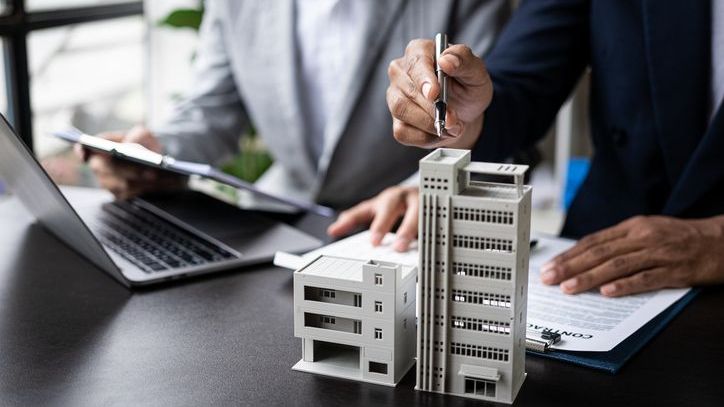Identifying profitable opportunities and avoiding pitfalls in the competitive commercial real estate market requires thorough due dilligence. To effectively evaluate commercial real estate investments, you need to consider factors such as location, tenant quality, lease terms and the overall financial health of the property. It’s a lot to think about, but there are some basics you’ll want to know to get started. Here are seven steps that can help you decide on a commercial investment.
A financial advisor may be able to help you evaluate and analyze different investment opportunities, including commercial real estate deals.
1. Understand Types of Commercial Real Estate
These five categories can help investors assess potential returns and risks associated with each type of property:
- Office buildings: These can range from skyscrapers in urban areas to small office parks in suburban settings. They generate income through leasing space to businesses.
- Retail properties: This includes shopping centers, strip malls, and standalone stores. Retail properties depend heavily on location and foot traffic.
- Industrial properties: Warehouses, manufacturing facilities, and distribution centers fall into this category. They are typically located in industrial zones with easy access to transportation networks.
- Multifamily housing: Apartment complexes and other residential buildings with multiple units are also considered commercial properties. These provide stable income through rent payments.
- Specialty real estate: Includes properties like hotels, healthcare facilities, and self-storage units. These often require specialized property management and operational knowledge.
2. Study the Location and Market
Location is an important factor to consider when evaluating a commercial real estate investment. A prime location can significantly impact the property’s value and potential return on investment (ROI). Examine the property’s proximity to major roads, public transportation and amenities. Good infrastructure enhances property value and attracts tenants.
Also study the local real estate market trends, including vacancy rates and rental prices. High demand and low vacancy rates indicate a thriving market. Consider any planned developments or zoning changes in the area. New projects can significantly impact property values and tenant interest.
Lastly, look into the neighborhood’s demographics and community profile. A growing, affluent population often signals a favorable investment climate.
3. Run the Numbers
Financial due diligence is the next step in analyzing a commercial real estate property. This process, which aims to assess the potential profitability of an investment, may include calculating the following financial metrics:
- Net operating income (NOI): Subtract the property’s operating expenses from its gross rental income to calculate the NOI. This metric can help you estimate how profitable a commercial may be before factoring in financial costs and taxes.
- Cap rate: The capitalization rate is calculated by dividing the NOI by the property’s purchase price. A higher cap rate indicates a potentially higher return on investment, but it may also imply higher risk.
- Gross rent multiplier (GRM): Divide the property’s sale price by gross rental income. This is known as the gross rent multiplier, and it offers a quick estimate of the investment’s value relative to its income.
- Cash flow: Analyze the property’s cash flow to determine the amount of money generated after all expenses, including mortgage payments, have been paid.
- Internal rate of return (IRR): Calculate the annual growth rate of the investment, considering both income and capital appreciation. IRR helps compare the profitability of different investments.
- Debt service coverage ratio (DSCR): This ratio measures the property’s ability to cover its debt obligations. A DSCR above 1 indicates that the property generates sufficient income to cover its debt.
4. Physically Inspect the Property

A thorough inspection of the property is necessary to identify any potential issues that could affect the value and profitability of your rental property. Evaluate the condition of the building’s foundation, roof, walls and other structural components. Also have the HVAC, plumbing, and electrical systems inspected.
Your physical inspection may include a review of past maintenance records to gain insight into the property’s history and any recurring issues. This can help you identify any maintenance issues that need immediate attention or could arise in the near future.
5. Conduct a Tenant Analysis
Understanding the quality and stability of tenants helps gauge the property’s income potential and risk.
First, assess the diversity and stability of the tenant mix. A well-diversified tenant base can reduce the risk of income loss. Examine financial stability of each tenant by reviewing credit scores, financial statements, and payment history.
Examine the length and conditions of current leases, including renewal options, rent escalations and termination clauses. Additionally, you’ll want to analyze current and historical occupancy rates to understand the property’s demand and potential for rental income growth.
6. Analyze the Comps
As with any real estate purchase, you’ll want to compare the target investment property to similar properties in the area. Looking at recent sales of similar properties in the area can help determine the fair market value of the property you’re considering.
Also assess the rental income of comparable properties. Higher rental rates can indicate a more valuable investment. Lastly, check the occupancy rates of similar properties because high occupancy rates suggest strong demand.
7. Legal and Regulatory Considerations
Various legal and regulatory factors should also be considered when analyzing a commercial real estate investment. Here are four factors to review:
- Zoning laws: These laws dictate how a property can be used, such as for residential, commercial, or industrial purposes. Ensure the property’s zoning aligns with your intended use.
- Environmental regulations: Properties must comply with environmental laws, which can include issues like soil contamination and hazardous materials. An environmental assessment may be required.
- Building codes and permits: Compliance with local building codes is necessary for construction and renovation projects. Check for required permits and ensure all construction meets safety standards.
- Taxes and incentives: Be aware of property taxes, potential tax benefits, and incentives for commercial properties, such as tax abatements or credits for certain types of development.
Financing Options and Loan Structures
The type of loan you choose and how it’s structured can significantly influence your cash flow, leverage, and long-term returns.
Common loan types include conventional bank loans, commercial mortgage-backed securities (CMBS) loans, and short-term bridge loans. Each option varies in terms of underwriting requirements, interest rates, and flexibility. For example, CMBS loans often have lower interest rates but come with less flexibility and stricter terms.
You’ll also want to consider the loan-to-value (LTV) ratio, which measures how much of the property’s value is being financed with debt. A lower LTV generally means less risk for lenders, and more equity required from the investor.
Interest rate structures, fixed vs. variable, can impact the predictability of your expenses. While fixed rates offer stability, variable rates may result in lower initial payments but increase risk during rising rate environments.
Other key features to evaluate include prepayment penalties and balloon payments, which can affect your ability to refinance or sell the property later.
Ultimately, how you finance a property plays a key role in its risk profile and potential return on investment. Be sure to model different scenarios to understand the impact of debt on your cash flow and exit strategy.
Exit Strategy Planning
Before investing in commercial real estate, it’s important to have a clear plan for how and when you’ll exit the investment. Your exit strategy can directly impact the property’s profitability and your ability to meet financial goals.
Common exit strategies include reselling the property at a profit, refinancing to pull out equity while retaining ownership, or using a 1031 exchange to defer capital gains taxes by reinvesting in another like-kind property.
Your intended timeline, whether short-term or long-term, can shape which strategy makes the most sense. A short-term investor may focus on rapid appreciation or value-add improvements, while a long-term investor may prioritize steady cash flow and gradual equity growth.
Market conditions also influence exit opportunities. Real estate cycles can determine whether it’s a buyer’s or seller’s market, which affects both timing and price.
Finally, it’s wise to plan for unexpected exits, such as changes in the local economy, tenant defaults, or shifting investment goals. Building in flexibility and having a contingency plan can help protect your capital if the market takes a turn.
Bottom Line

Analyzing commercial real estate investments requires a comprehensive understanding of market dynamics, property valuations, and revenue streams. Location, tenant quality, lease terms, and the financial health of a property all influence potential risks and rewards. This holistic approach, supported by detailed financial analysis and property inspections, can help you make an informed investment decision.
Real Estate Investing Tips
- Being a successful real estate investor isn’t just about buying and managing investment properties. Leveraging the unique tax advantages associated with owning real estate can make direct investments even more lucrative. From tax deductions and depreciation to 1031 exchanges and passthrough deductions, some of a real estate investment’s value lies in the tax benefits it offers.
- Finding a financial advisor doesn’t have to be hard. SmartAsset’s free tool matches you with up to three vetted financial advisors who serve your area, and you can have a free introductory call with your advisor matches to decide which one you feel is right for you. If you’re ready to find an advisor who can help you achieve your financial goals, get started now.
Photo credit: ©iStock.com/FG Trade, ©iStock.com/damircudic, ©iStock.com/ArLawKa AungTun
